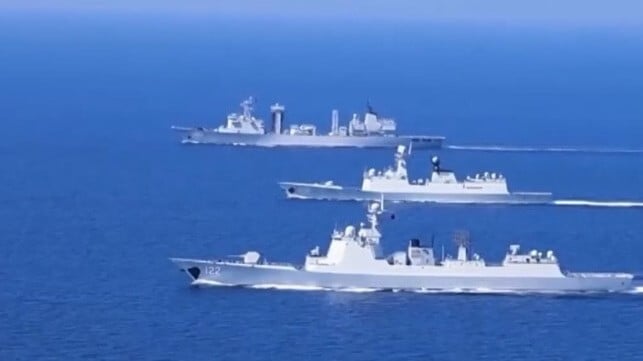Chinese 48th Escort Group Takes Over in Djibouti

The People’s Liberation Army Navy (PLAN) has officially commenced its 48th Naval Escort Group’s mission in the Red Sea and Gulf of Aden. This deployment, which is expected to last around ten months, is based at the Project 141 Overseas Support Base in Doraleh, Djibouti. The flotilla set sail from Qingdao, Shandong Province, on October 11, marking a significant step in China’s naval operations in the region.
New Flotilla Takes Charge
The 48th Naval Escort Group comprises three key vessels: the Type 052DL guided-missile destroyer Tangshan (F122), the Type 054A guided-missile frigate Daqing (F576), and the Type 903A replenishment ship Taihu (K889). Their first mission involved escorting the Panamanian-registered bulk carrier Nasco Gem (IMO 9404986) through the Gulf of Aden and into Djibouti. The Nasco Gem had departed from Lianyungang in Jiangsu Province, making a stop in Singapore before reaching its destination. This vessel is owned by YDM Shipping Co and managed by NASCO, both of which are based in China.
Interestingly, the PLA’s military website mistakenly identified the escorted vessel as the Nasco Diamond (IMO 9467861), a bulk carrier that tragically sank off Japan’s southern islands in 2010. The Nasco Diamond had encountered issues with its cargo of nickel ore, leading to its foundering. The Nasco Gem, which the PLAN escorted, is a sister ship to the Nasco Diamond and remains under the same management, highlighting the ongoing connections between these vessels.
Djibouti Offers Port to Ethiopia in Hopes of Easing Regional Tensions
Transition of Naval Forces
The 48th Naval Escort Group has taken over from the 47th Naval Escort Group, which included the Type 052D guided-missile destroyer Baotou (F113), the Type 054A guided-missile frigate Honghe (F523), and the Type 903A replenishment ship Gaoyouhu (K904). The relieved group is currently en route back to the East Sea Fleet’s main base in Ningbo, Zhejiang Province, likely making several port calls along the way. This transition underscores China’s commitment to maintaining a robust naval presence in critical maritime regions, ensuring the safety of its shipping routes and interests.
